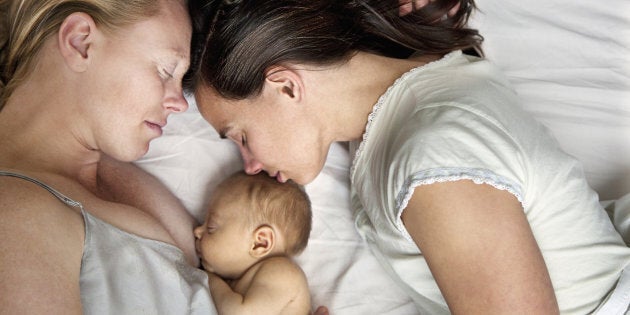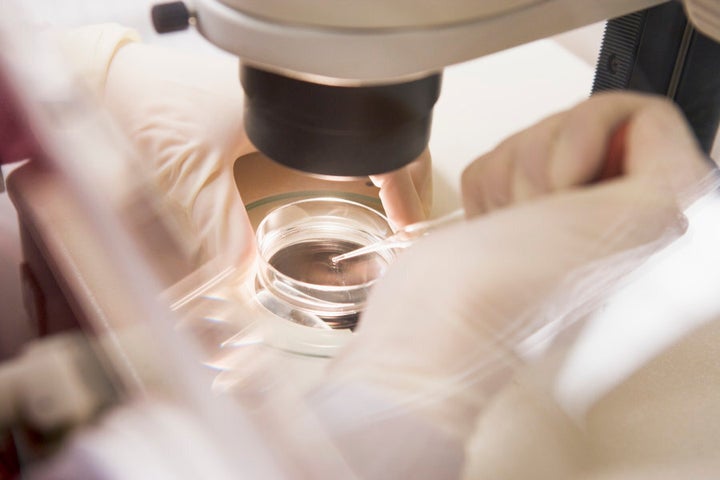

Conceiving a baby via In Vitro Fertilisation (IVF) is no longer something couples keep under wraps. It's believed one in six Australian couples have trouble conceiving naturally, and many of those end up using IVF to help them to have a family.
In 2014, out of the 299,700 babies born in Australia, 12,875 were conceived through IVF. That's an increase of 21 percent from 2010 -- and the numbers are still rising, according to Medical Director at IVF Australia, Professor Peter Illingworth.
"While IVF is mainly used to help women with tubal damage or in couples where the man had a low sperm count, now there's a wider range of causes -- from problems with a woman's uterus, to difficulties with ovulation. It allows women and couples of all types who would previously not have had the chance to have a baby to start a family. IVF doesn't discriminate."
In fact, as these three parents prove, people of all sorts of ages and backgrounds are utilising IVF treatments to start, or expand, their families.
Kate and her partner Edwina used an anonymous sperm donor, egg sharing and IVF in order to fall pregnant. Their daughter was born in June.
"I've always wanted to be a mum. I first looked in to IVF in 2012; I was 33, gay and single and worried I wasn't going to find the right person to embark on parenthood with.
But when I started seeing my partner, Edwina, I put my IVF plans on hold, and two years later we embarked on our IVF journey as a couple.
We tried IUI (intrauterine insemination) first which didn't work, so then we started a full IVF cycle. We were extremely excited -- in hindsight we were blissfully naïve about the challenges that lay ahead.
We decided to use an anonymous sperm donor and wanted the legal protection offered by an IVF clinic. From our first appointment, everyone we dealt with was fantastic. From our doctor, Dr Marcela Martin, to the donor team, everyone was so patient with our never-ending questions.
Tests showed my fertility levels were low because endometriosis had damaged my ovaries, but Dr Martin reassured me I could get pregnant. We tried intrauterine insemination (IUI) first, which didn't work, so then we started a full IVF cycle. We were extremely excited -- in hindsight we were blissfully naïve about the challenges that lay ahead.

My first IVF cycle only produced three eggs which resulted in three embryos, and only one was viable for transfer -- which was unsuccessful. I was disappointed but wanted to try again. I completed four more cycles, with different doses and combinations of drugs to assist my egg production.
With each failed cycle, it became a little harder to stay positive. After each egg collection I'd wake up from the anesthetic, look down at my hand where the doctor had written the number of eggs that had been successfully collected, and hope with all my heart that at least one would be viable for transfer. But none of my embryos lasted the distance.
When Dr Martin gently told me it was time to look at other options, I was devastated. We discussed our options and decided that as a same sex couple, Ed could "share" her eggs with me. She completed a successful IVF cycle which produced several viable embryos and in October 2016, we did a transfer using Ed's embryo.
It wasn't until I held my beautiful daughter Ellie for the first time that I truly dared believe we had our baby. It was the most overwhelming moment of my life.
I was at work when I got the phone call telling me I was pregnant -- I was elated and terrified at the same time. These conflicting emotions lasted my entire pregnancy.
It wasn't until I held my beautiful daughter Ellie for the first time that I truly dared believe we had our baby. It was the most overwhelming moment of my life. It's impossible to put into words how grateful I am to Ed for giving me the opportunity to experience pregnancy and birth.
While the IVF process can be extremely challenging emotionally, physically and financially, a positive end result makes it all worthwhile. Despite having not survived on this little sleep since doing a Contiki Tour in the '90s, I absolutely love being a mum. Ellie makes it very easy to forget all the tough times we went through to get her."
After nearly a decade of trying for a baby, Linda was 45 when she and her husband Kent became parents after two rounds of IVF.
"When I was 35, Kent and I started trying for a baby. Nothing happened. We saw various fertility doctors and had several tests but they were all inconclusive.
When I was 42, a client told me about her IVF experience and gave me her doctor's phone number. It took me a year to pluck up the courage to call Professor Illingworth.
There were no answers for us and I was desperately disappointed. I so wanted to be a mum but I decided I had to learn to live with the life we had -- even though it was heartbreaking not being parents.
Then, when I was 42, a client told me about her IVF experience and gave me her doctor's phone number. It took me a year to pluck up the courage to call Professor Illingworth, but I decided that unless I gave it a go, I'd never know what could happen.
Our first appointment was overwhelming; he told me I may not have enough eggs because of my age. I was quite upset about the statistics and broke down in tears, but having a counsellor in the room helped. Luckily tests showed my egg reserves were high, so Kent and I decided we would try one round of IVF.
When I got the phone call from the clinic saying the transfer had been successful and I was pregnant, I was crying so much I couldn't talk. It was the best moment ever.
They managed to collect 14 eggs -- which is a lot -- but in the lab only one made it to an embryo. Then the transfer didn't stick. For a week I grieved, but then I told Kent I had another two rounds in me. If it didn't work after that, we'd stop. They collected another 14 eggs and this time we got two embryos.

When I got the phone call from the clinic saying the transfer had been successful and I was pregnant, I was crying so much I couldn't talk. It was the best moment ever.
Poppy was born six months ago, and when I saw her, it was like I already knew her. We are so lucky to have her. I feel like she was meant to be -- I just wish that I could have known her 10 years ago. I'd love a sibling for her. We have one embryo left so we'll see what happens."
Adriana and her husband James used IVF to conceive their daughter three years ago, and then a mosaic embryo and IVF to conceive their son who was born in August
"After I had four miscarriages in a row, the IVF process helped give us some control -- it made us feel we were using all the tools available to tip the scales in our favour.
Our daughter was conceived using IVF three years ago and when we started thinking about having a second baby, our doctor suggested genetic testing to help avoid further miscarriages.
The new testing process is more advanced. It can show that some of the cells in the embryo were good and for us one of the cells was not. This is called a mosaic embryo.
This process helps eliminate embryos that, due to their genetic makeup, would never have implanted and resulted in a successful pregnancy. We did the gene testing in all rounds of the IVF and it helped ensure we weren't wasting any time transferring embryos that would never work out.
Previously these tests just looked at one cell, but the new testing process is more advanced. It can show that some of the cells in the embryo were good and for us, and that one of the cells was not. This is called a mosaic embryo.
When we discovered we had a couple of mosaic embryos we consulted with a genetic specialist who talked us through which embryos were safe to implant.
It created new things to consider, such as which genes were affected and what impact that would cause if the "bad" cell multiplied.
IVF can be a brutal process and initially we felt a bit angry about doing it, as there's an expectation that babies should just come naturally. But once we embraced a more scientific approach it got easier.
The gene mix in our tested cells was such that either the pregnancy would not take at all or we'd have a perfectly normal baby.
IVF can be a brutal process and initially we felt a bit angry about doing it, as there's an expectation that babies should just come naturally. But once we embraced a more scientific approach it got easier. I had daily injections and several operations to extract my eggs.
The drugs really played with my moods, and my ovaries swelled up like mangos. Every time the transfer didn't stick it was awful. We would cry it out and then get back in the ring for another round. The IVF team are very supportive, but it's still devastating.
For us, getting straight back into another cycle made it feel like we were still in the fight. We'd lost the battle, but if we just kept going we could still win the war.
Other things helped too; looking at the bill for each cycle one by one was awful so we decided to set aside $50k and once we spent that, we'd review it again. This meant we needed to make fewer decisions which seemed to reduce stress.
I don't think I ever really accepted the idea we were having another baby until he was actually in my arms.
From the start of the injections it took us six months to fall pregnant. When I got the call from the clinic telling me I was pregnant, it only made me more worried -- I felt like I had more to lose. We had an amniocentesis at 16 weeks to ensure that only the genetically normal cells had been multiplying and the bad one had disappeared, which was the case for us.

I don't think I ever really accepted the idea we were having another baby until he was actually in my arms. Holding your baby for the first time is super special whatever your circumstances, but perhaps the hardships of IVF make meeting your baby extra satisfying.
As members of Virtus Health, IVFAustralia, Melbourne IVF, Queensland Fertility Group and TasIVF create more babies than any other fertility group. If you're planning for pregnancy or already trying, get expert advice from our specialists today.